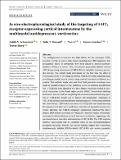Files in this item
In vivo electrophysiological study of the targeting of 5-HT3 receptor-expressing cortical interneurons by the multimodal antidepressant, vortioxetine
Item metadata
| dc.contributor.author | Schweimer, Judith | |
| dc.contributor.author | Brouard, Julia T. | |
| dc.contributor.author | Li, Yan | |
| dc.contributor.author | Sánchez, Connie | |
| dc.contributor.author | Sharp, Trevor | |
| dc.date.accessioned | 2022-03-08T17:30:09Z | |
| dc.date.available | 2022-03-08T17:30:09Z | |
| dc.date.issued | 2022-03-03 | |
| dc.identifier | 277815785 | |
| dc.identifier | 666d3e41-091f-4282-bb57-7c3449e7d0ed | |
| dc.identifier | 85125771967 | |
| dc.identifier | 000763903800001 | |
| dc.identifier.citation | Schweimer , J , Brouard , J T , Li , Y , Sánchez , C & Sharp , T 2022 , ' In vivo electrophysiological study of the targeting of 5-HT 3 receptor-expressing cortical interneurons by the multimodal antidepressant, vortioxetine ' , European Journal of Neuroscience , vol. Early View . https://doi.org/10.1111/ejn.15623 | en |
| dc.identifier.issn | 0953-816X | |
| dc.identifier.other | ORCID: /0000-0002-5968-3534/work/109766887 | |
| dc.identifier.uri | https://hdl.handle.net/10023/25011 | |
| dc.description | This study was supported by an educational grant from H. Lundbeck A/S. | en |
| dc.description.abstract | The antidepressant vortioxetine has high affinity for the ionotropic 5-HT3 receptor (5-HT3R) as well as other targets including the 5-HT transporter. The procognitive effects of vortioxetine have been linked to altered excitatory:inhibitory balance in cortex. Thus, vortioxetine purportedly inhibits cortical 5-HT3R-expressing interneurons (5-HT3R-INs) to disinhibit excitatory pyramidal neurons. The current study determined for the first time, the effect of vortioxetine on the in vivo firing of putative 5-HT3R-INs whilst simultaneously recording pyramidal neuron activity using cortical slow-wave oscillations as a readout. Extracellular single unit and local field potential recordings were made in superficial layers of the prefrontal cortex of urethane-anaesthetised rats. 5-HT3R-INs were identified by a short-latency excitation evoked by electrical stimulation of the dorsal raphe nucleus (DRN). Juxtacellular-labelling found such neurons had the morphological and immunohistochemical properties of 5-HT3R-INs; basket cell or bipolar cell morphology, expression of 5-HT3R-IN markers, and parvalbumin-immunonegative. Vortioxetine inhibited the short-latency DRN-evoked excitation of 5-HT3R-INs and simultaneously decreased cortical slow wave oscillations, indicative of pyramidal neuron activation. Likewise, the 5-HT3R antagonist ondansetron inhibited the short-latency DRN-evoked excitation of 5-HT3R-INs. However unlike vortioxetine, ondansetron did not decrease cortical slow-wave oscillations suggesting a dissociation between this effect and inhibition of 5-HT3R-INs. The 5-HT reuptake inhibitor escitalopram had no consistent effect on any electrophysiological parameter measured. Overall, the current findings suggest that vortioxetine simultaneously inhibits (DRN-evoked) 5-HT3R-INs and excites pyramidal neurons, thereby changing the excitatory:inhibitory balance in cortex. However, under the current experimental conditions these two effects were dissociable with only the former likely involving a 5-HT3R-mediated mechanism. | |
| dc.format.extent | 15 | |
| dc.format.extent | 3352558 | |
| dc.language.iso | eng | |
| dc.relation.ispartof | European Journal of Neuroscience | en |
| dc.subject | Dorsal raphe nucleus | en |
| dc.subject | Electrical stimulation | en |
| dc.subject | Juxtacellular labelling | en |
| dc.subject | Immunohistochemistry | en |
| dc.subject | Serotonin | en |
| dc.subject | RC0321 Neuroscience. Biological psychiatry. Neuropsychiatry | en |
| dc.subject | RM Therapeutics. Pharmacology | en |
| dc.subject | NDAS | en |
| dc.subject.lcc | RC0321 | en |
| dc.subject.lcc | RM | en |
| dc.title | In vivo electrophysiological study of the targeting of 5-HT3 receptor-expressing cortical interneurons by the multimodal antidepressant, vortioxetine | en |
| dc.type | Journal article | en |
| dc.contributor.institution | University of St Andrews. School of Psychology and Neuroscience | en |
| dc.identifier.doi | 10.1111/ejn.15623 | |
| dc.description.status | Peer reviewed | en |
This item appears in the following Collection(s)
Items in the St Andrews Research Repository are protected by copyright, with all rights reserved, unless otherwise indicated.

